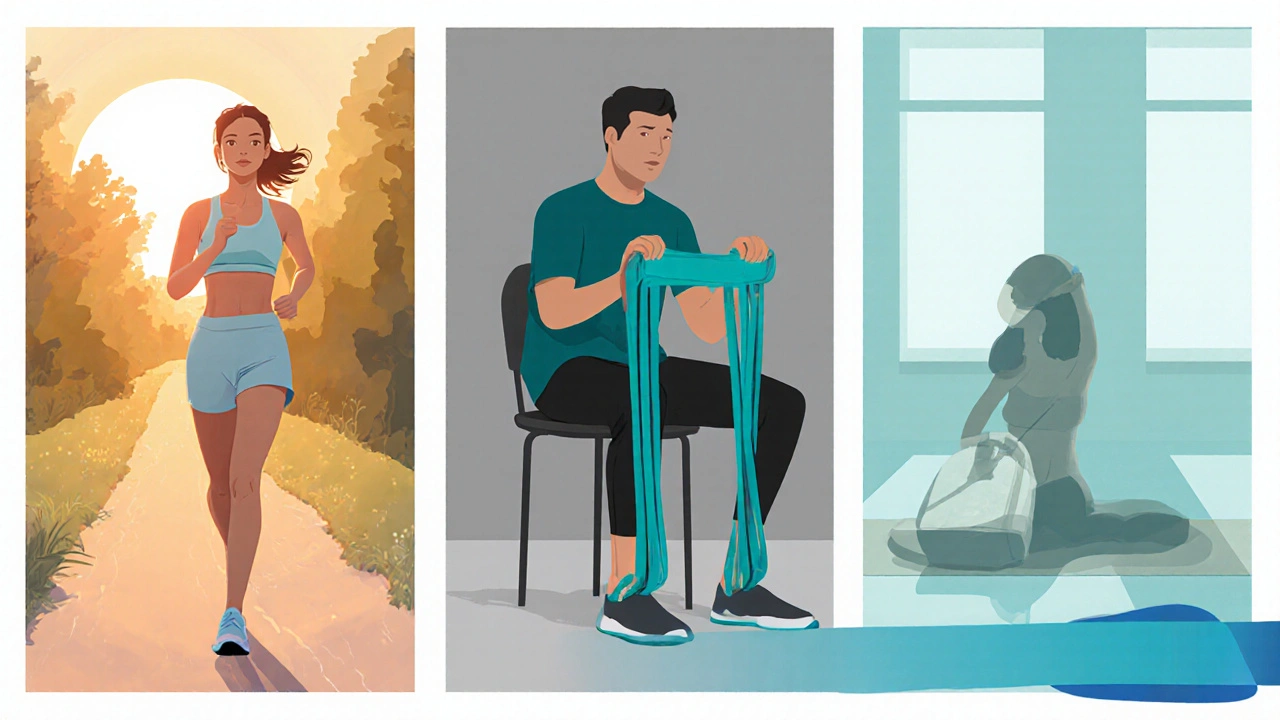PHN Exercise Progress Tracker
Exercise Categories
Aerobic
Low-impact cardio for circulation and endorphins
- Walking
- Cycling
- Water aerobics
Strength
Light resistance for muscle support
- Resistance bands
- Bodyweight exercises
- Seated rows
Flexibility
Gentle stretches for nerve desensitization
- Yoga
- Stretching
- Tai Chi
Weekly Progress
You've completed 65% of your weekly goals
Pain Management Tips
Current Routine Summary
Quick Takeaways
- Start with low‑impact activities like walking or gentle yoga to avoid aggravating pain.
- Progress gradually - add 5‑10 minutes each week once you feel comfortable.
- Combine aerobic, strength, and flexibility work for the best pain‑relief blend.
- Listen to your body: stop if pain spikes and consult a physiotherapist.
- Use heat, topical analgesics, or prescribed meds before sessions if needed.
Living with postherpetic neuralgia can feel like walking a tightrope - you want to stay active, but too much movement can flare the burning, stabbing sensations that linger after shingles. This guide walks you through the science, the safest exercise choices, and a step‑by‑step plan to keep you moving without turning pain into a roadblock.
What Is Postherpetic Neuralgia?
When shingles heals, Postherpetic Neuralgia is a chronic nerve pain condition that can persist for months or years. It arises from damaged sensory nerves following the varicella‑zoster virus infection. About 10‑20% of shingles sufferers develop PHN, and the risk climbs with age - people over 60 are most vulnerable. Typical symptoms include burning, throbbing, or electric‑shock sensations along the rash’s former path, and even light touch can feel like a sting.
Why Exercise Still Matters
It might sound counter‑intuitive, but regular movement can actually dial down nerve pain. Research from the British Pain Society (2023) showed that participants who engaged in 30minutes of moderate aerobic exercise three times a week reported a 25% drop in PHN intensity after eight weeks. Exercise works in three key ways:
- Endorphin boost - natural painkillers released by the brain.
- Improved blood flow - helps clear inflammatory mediators around damaged nerves.
- Neuroplasticity - gentle stress on the nervous system encourages it to rewire around damaged fibers.
That said, the wrong type or intensity can worsen symptoms. The goal is a balanced program that respects the fragility of the affected nerves.
Key Exercise Types for PHN
Below is a quick comparison of the three main categories most clinicians recommend for nerve‑pain patients.
| Exercise Type | Primary Benefit for PHN | Risk Level | Sample Activities |
|---|---|---|---|
| Aerobic (low‑impact) | Boosts endorphins, improves circulation | Low | Brisk walking, stationary cycling, water aerobics |
| Strength Training | Supports posture, reduces muscle tension | Moderate - avoid heavy loads on affected side | Resistance bands, body‑weight squats, seated rows |
| Flexibility / Mobility | Gentle nerve desensitization, reduces stiffness | Very low | Yoga, tai chi, guided stretching |
Getting Started: The First 2‑Week Plan
Remember, the safest approach is to treat exercise like medication - start low, go slow, and monitor response.
- Day 1‑3: 10‑minute walk at a comfortable pace. Use supportive shoes, keep shoulders relaxed.
- Day 4‑7: Add a 5‑minute gentle stretching routine after the walk (see “Basic Stretch Set” below).
- Day 8‑10: Introduce a 5‑minute session of resistance‑band rows using a light (2lb) band.
- Day 11‑14: Combine walk (15min) + stretch (5min) + band rows (5min). If any activity spikes pain, trim the duration or pause.
Track your pain on a simple 0‑10 scale each day. If the average stays the same or drops, you’re on the right track.
Basic Stretch Set (Flexibility)
These moves are designed to be painless, but stop if you feel a sharp sting.
- Neck tilt: Gently bring ear toward shoulder, hold 10seconds each side.
- Upper‑back cat‑cow: On hands‑and‑knees, arch and round back, 8 reps.
- Chest opener: Stand in a doorway, place forearms on the frame, lean forward slightly for 15seconds.
- Hamstring stretch: Sit on a chair, extend one leg, lean forward until you feel a mild pull, 20seconds each leg.

Strength Work: Safe Band Exercises
Strength training helps keep muscles from over‑compensating and pulling on nerves. Use the resistance band to keep loads light.
- Seated rows: Sit, loop band around feet, pull toward torso, squeeze shoulder blades, 2sets of 12.
- Standing hip extensions: Anchor band low, step back, extend opposite leg, 2sets of 10 per side.
- Wall push‑ups: Hands on wall, lower chest, 2sets of 15 - excellent for upper‑body endurance without joint stress.
Rest 30‑60seconds between sets. If you hear a “pin‑prick” sensation, reduce the range of motion.
Monitoring Pain and Adjusting
PHN pain can be fickle - some days are better, others worse. Use these rules of thumb:
- 2‑point rule: If pain rises by more than 2 points on your scale after a session, cut the duration in half next time.
- Time‑of‑day check: Many people feel less nerve pain in the late afternoon; schedule tougher workouts then.
- Heat before movement: A 10‑minute warm‑up with a heating pad can soften stiff skin and reduce hypersensitivity.
When pain spikes despite modifications, pause the program for 48hours and consult a physiotherapist. They can adjust techniques, suggest splints, or provide manual therapy.
When to Seek Professional Help
Exercise is a tool, not a cure. If any of the following happen, it’s time to call a clinician:
- Pain consistently stays above 7/10 despite low‑impact work.
- New numbness, weakness, or loss of balance appears.
- Medication needs increase (e.g., more gabapentin) just to finish a workout.
A multidisciplinary approach - combining antiviral therapy (if shingles is still recent), analgesics, and targeted physiotherapy - yields the best outcomes.
Putting It All Together: A Weekly Sample Schedule
| Day | Activity | Duration | Notes |
|---|---|---|---|
| Monday | Brisk walk + basic stretch set | 15min walk, 5min stretch | Warm‑up with heating pad |
| Tuesday | Resistance‑band rows + wall push‑ups | 10min total | Keep breathing steady |
| Wednesday | Water aerobics (if pool available) | 20min | Low joint stress, great for circulation |
| Thursday | Rest or gentle yoga | 15min | Focus on deep breathing |
| Friday | Walk + stretch + band rows | 20min walk, 5min stretch, 5min band | Check pain scale after |
| Saturday | Light cycling (stationary) | 15min | Keep resistance low |
| Sunday | Rest or gentle stretching | 10min | Prepare for next week |
Feel free to shuffle days to match your energy levels. Consistency beats intensity when dealing with nerve pain.
Common Pitfalls and How to Avoid Them
- Skipping warm‑up: Jumping straight into activity can trigger hyper‑sensitive nerves.
- Over‑reaching: Stretching to the point of pain does more harm than good.
- Ignoring rest days: Recovery is where the nervous system repairs.
- Relying on “no pain, no gain”: For PHN, a mild stretch‑or‑burn sensation is a red flag.
Bottom Line: Move Smart, Live Better
Finding the right balance between activity and comfort is a personal experiment. By starting with low‑impact aerobic work, layering gentle strength, and finishing with soothing flexibility drills, you give your nervous system the conditions it needs to calm down. Keep a simple pain diary, stay in touch with a physiotherapist, and remember that every little step adds up to bigger relief.
Frequently Asked Questions
Can I do high‑intensity interval training (HIIT) with PHN?
HIIT spikes heart rate and often involves rapid, jarring movements that can aggravate nerve irritation. Most specialists recommend reserving HIIT for later stages, once baseline pain is consistently low (<4/10) and you have built a solid foundation of low‑impact cardio.
Is swimming safe for PHN?
Yes. The buoyancy of water reduces joint stress and the warm temperature can soothe hypersensitive skin. Aim for gentle laps or water‑based aerobics, and avoid harsh strokes that twist the torso excessively.
Should I take pain medication before exercising?
A low dose of an analgesic (e.g., acetaminophen or a prescribed gabapentin) taken 30minutes pre‑workout can make movement more tolerable. Always follow your doctor’s dosage instructions and note any side‑effects that could affect balance.
What if my pain spikes after a session?
Give the area at least 48hours of rest, apply a cool pack for 15minutes, and evaluate whether the activity’s intensity or range of motion was too high. If spikes become frequent, scale back to a gentler version or consult a physiotherapist for a customized modification.
Can yoga help with PHN?
Yoga offers controlled stretching, breath work, and mindfulness, all of which can lower central sensitization. Choose a restorative or gentle style, avoid deep twists on the affected side, and use props (bolsters, blocks) to keep pressure low.








Posts Comments
Nicole Hernandez October 2, 2025 AT 19:03
Thank you for putting together such a thorough guide on navigating post‑herpetic neuralgia. The step‑by‑step plan feels both practical and adaptable, which is crucial for individuals dealing with fluctuating pain levels. I especially appreciate the emphasis on the “2‑point rule” as a simple way to self‑monitor progress. Your inclusion of both aerobic and flexibility options offers a balanced approach that respects the fragility of damaged nerves. Overall, this resource should empower many to stay active without risking setbacks.
florence tobiag October 2, 2025 AT 20:26
Wow-another “miracle” exercise plan, huh??? You’d think anyone copying this would magically cure their PHN, yet the reality is far more nuanced!!! The insistence on heat pads feels like a gimmick, and the 2‑point rule is barely a safety net-what about those whose pain spikes beyond measurement??? Honestly, I’m skeptical of any “one‑size‑fits‑all” regimen, especially when it’s dressed up in glossy language!!!
Terry Washington October 2, 2025 AT 21:50
Frankly, this article epitomizes the pseudo‑scientific drivel that proliferates under the guise of “evidence‑based” physiotherapy. The reliance on anecdotal metrics like “pain diaries” substitutes for rigorous quantitative analysis, rendering the protocol intellectually vacuous. Moreover, the recommended low‑impact aerobics betray a patronizing assumption that PHN sufferers lack the physiological capacity for more strenuous activity. Such an oversimplified schema not only undermines patient autonomy but also perpetuates a mediocre standard of care. In short, the recommendations are a regurgitation of generic wellness platitudes, devoid of substantive biomechanical insight.
Claire Smith October 2, 2025 AT 23:13
The guide feels overly generic.
Émilie Maurice October 3, 2025 AT 00:36
While the article does cover essential points, it lacks depth in explaining the underlying mechanisms of nerve desensitization. Additionally, the formatting could be streamlined for better readability.
Ellie Haynal October 3, 2025 AT 02:00
I loved how you tied in both the scientific rationale and the everyday practicality of each exercise. It’s refreshing to see a guide that doesn’t just list movements but actually explains why they matter for nerve pain. The tone feels supportive without being condescending, which is a rare balance. Also, the reminder to consult a physiotherapist adds a needed safety net. Overall, this post is a solid blend of empathy and expertise.
Jimmy Gammell October 3, 2025 AT 03:23
Great job laying out a clear, step‑by‑step schedule-this is exactly the kind of roadmap many of us need! 😊 Starting with low‑impact walks and gradually adding resistance bands makes the progression feel safe yet effective. Remember to keep the heating pad on a warm, not scorching, setting to avoid skin irritation. If you ever feel a sudden surge in pain, don’t push through; dial back and reassess. Keep tracking those pain scores, and you’ll soon see the pattern of improvement. 👍
fred warner October 3, 2025 AT 04:46
Absolutely, consistency paired with mindful adjustments is the cornerstone of sustainable progress. Your emphasis on listening to the body, rather than forcing metrics, aligns perfectly with best practice guidelines.
Veronica Mayfair October 3, 2025 AT 06:10
Wow, this guide is like a warm hug for anyone battling PHN! 🤗 The blend of science and kindness really shines through. Keep spreading the love and knowledge! 🌟
Rahul Kr October 3, 2025 AT 07:33
Interesting read; the balance between aerobic and flexibility work seems well thought out. I’ll consider integrating some of these stretches into my routine.
Anthony Coppedge October 3, 2025 AT 08:56
I must say, this article manages to cover a surprisingly wide array of considerations pertaining to postherpetic neuralgia and exercise.
From the outset, the author acknowledges the paradox that movement can both alleviate and exacerbate nerve pain, which is a nuance often ignored in mainstream fitness advice.
The inclusion of a simple 0‑10 pain tracking system provides an accessible quantifiable metric that empowers patients to self‑monitor without requiring specialized equipment.
Moreover, the suggestion to apply a heating pad before activity is grounded in the physiological principle that increased tissue temperature can improve vascular perfusion.
The three‑tiered exercise categorization- aerobic, strength, flexibility-mirrors the multimodal approach advocated by most pain management specialists.
I appreciate the specific examples under each category, such as water aerobics for low-impact cardio, which also offers buoyancy‑mediated joint protection.
The strength component wisely limits resistance to light bands, thereby reducing the risk of overloading vulnerable nerves.
Flexibility exercises are presented with clear duration guidelines, which helps to prevent overstretching that could trigger hyper‑sensitivity.
The weekly progress tracker, though simplistic, gives users a visual cue for adherence, which is crucial for habit formation.
The 2‑point rule functions as a safety net, effectively translating subjective pain perception into actionable adjustments.
I also like the recommendation to schedule more demanding sessions in the late afternoon, when endogenous endorphin levels tend to be higher.
The article does not shy away from warning signs, listing clear thresholds for seeking professional help, such as persistent pain above a 7/10.
This level of detail reflects a commendable respect for patient autonomy while still emphasizing clinical vigilance.
However, one area that could be expanded is the discussion of adjunctive therapies like transcutaneous electrical nerve stimulation, which have shown promise in recent trials.
Additionally, a brief note on nutritional support, such as adequate B‑vitamin intake, would round out the holistic perspective.
Overall, the guide strikes a pragmatic balance between scientific rigor and user‑friendly language, making it a valuable tool for anyone navigating the challenges of PHN.
Joshua Logronio October 3, 2025 AT 10:20
Honestly, I think the whole “heat pad” recommendation is a way for pharma to sell more topical creams-stay skeptical, buddy.
Nicholas Blackburn October 3, 2025 AT 11:43
The so‑called “gentle” stretches are anything but gentle when you’ve got raw nerves screaming for relief; it’s a thinly veiled marketing ploy that downplays genuine suffering. Anyone peddling these generic routines without acknowledging the psychological toll is doing a disservice. Wake up and demand personalized care, not cookie‑cutter advice.
Dave Barnes October 3, 2025 AT 13:06
One could argue that the very act of moving through pain is a metaphysical negotiation with one’s own mortality; the body, after all, is a perpetual dialogue between entropy and resilience. Yet, the guide curiously sidesteps this deeper contemplation in favor of checklist‑driven routines. Perhaps that’s intentional-to keep the focus pragmatic, or perhaps it’s an oversight. In any case, the practical steps remain valuable, even if they lack poetic flourish.
Kai Röder October 3, 2025 AT 14:30
Your philosophical framing adds a refreshing layer to what could have been a purely mechanical guide. It reminds us that exercise is as much a mental practice as a physical one.
Brandi Thompson October 3, 2025 AT 15:53
Honestly, this whole post reads like a corporate wellness brochure that was drafted by somebody who has never actually felt the burning, electric jolt of postherpetic neuralgia and therefore is completely out of touch with the lived reality of sufferers who are forced to navigate a labyrinth of pain with only vague guidelines to cling to the way the author casually glides over the severe psychological toll that chronic nerve pain imposes on a person's identity and social relationships in a manner that is frankly dismissive and unsettling the suggestion that a simple heat pad can magically neutralize a deep‑seated neuropathic fire simply does not hold up under scrutiny yet the article proceeds to sprinkle buzzwords like “endogenous endorphin boost” without offering any substantive evidence or referencing peer‑reviewed studies the entire piece feels like a patchwork of half‑baked ideas stitched together with optimism that borders on naïveté and ultimately does a disservice to those who are desperately seeking actionable, evidence‑based strategies to reclaim a semblance of normalcy
Chip Hutchison October 3, 2025 AT 17:16
I see your point about the need for more rigorous citations; a bibliography would definitely bolster credibility. Perhaps future updates could incorporate meta‑analysis references.
Emily Moody October 3, 2025 AT 18:40
Never let anyone tell you pain is an excuse-fight it like a warrior!
Write a comment